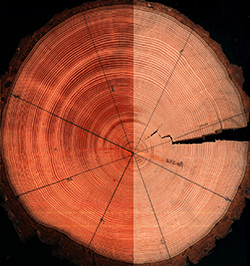Arctic study sheds light on tree-ring divergence problem
Changes in light intensity may impact density of tree rings, SF State researcher finds
May 7, 2014 -- Changes in tree-ring density in the Arctic may be evidence of changes in light intensity during the trees' growth, according to a new study by San Francisco State University researcher Alexander Stine.
Assistant Professor of Earth & Climate Sciences Alexander Stine writes that changes in Arctic tree-ring density may be evidence of changes in light intensity during the trees' growth.
The finding has direct implications for the tree-ring "divergence problem," a phenomenon that has received considerable media attention but has been widely misinterpreted, said Stine, an assistant professor of Earth & climate sciences.
Tree rings consist of a low density ring, which forms early in the growing season, and a high density ring that forms late in the growing season. In colder parts of the world, the dense latewood rings tend to be denser during warm years. Temperature records inferred from Arctic tree rings do a good job of tracking temperature up until the 1960s, but subsequent Arctic tree-ring densities did not keep pace with increases in temperature, a discrepancy that is called the divergence problem.
Climate scientists have been aware of the divergence problem for some time, and it was mentioned in the emails from the Climatic Research Unit at the University of East Anglia, where it became the focus of attention during the 2009 "Climategate" controversy.
The divergence is not a problem for understanding modern climate change in the Arctic, Stine explained, "because we have thermometers and those thermometers tell us it's warming. But it's a problem because if we want to use these tree rings as a proxy for temperatures of the past, we need to make sure that we understand what's happening now."
Stine sees the new findings as the "bright side" of the divergence problem, one which he hopes will lead to a more informed discussion about climate change. "We could learn more about past variations in light intensity at the Earth's surface, and we may be able to deepen our understanding of both trees and climate."
With his colleague Peter Huybers at Harvard University, Stine set out to understand why tree-ring density was declining in the Arctic. One possible explanation, the two thought, might be changes in light intensity that affected the trees' ability to grow. Starting in the 1960s, the amount of sunlight reaching the Earth's surface has declined. Scientists debate the cause of this "global dimming," with many scientists attributing it to pollution particles injected into the atmosphere by human activity that deflect incoming sunlight.

Tree rings consist of a low density ring and a high density ring. In colder parts of the world, the dense rings tend to be denser during warm years, but that trend has not been seen in the Arctic over the past few decades, leading to what is called the 'divergence problem.'
The researchers tested whether global dimming might be responsible for the decline in tree-ring density in the Arctic. This idea had been proposed in the past, but scientists had not been able to test the hypothesis. "It's very hard to distinguish a record that's controlled by temperature from one that's controlled by light, because light and temperature tend to vary together. Sunnier days are usually warmer," Stine added.
To get around this challenge, the researchers took advantage of the fact that there are regional variations in cloud cover and light availability throughout the Arctic, allowing them to compare trees that grew in the brightest and darkest areas but in comparable temperature ranges. They found that divergence was largest in the darkest parts of the Arctic, where changes in light should have the largest effect.
The researchers used changes in tree-ring density following volcanic eruptions to confirm the findings. Major volcanic events such as the 1991 eruption of Mount Pinatubo in the Philippines also have spewed tons of light-scattering sulfur dioxide particles into the atmosphere, decreasing the amount of sunlight reaching the surface.
Their analysis for seven different tree species suggests variations in light intensity caused by volcanic eruptions and global dimming both affect tree-ring density, and this impact is greatest in the darkest Arctic regions. In the brightest areas, the divergence problem essentially disappears, and tree-ring density is most closely linked to temperature instead.
Stine said the findings could have implications for geoengineering proposals that would pump more aerosol particles into the atmosphere as a way to block sunlight and potentially cool a warming planet. The tree-ring study suggests that Arctic trees might not grow as much -- and thus not soak up as much atmosphere-polluting carbon -- under such a plan.
The paper "Arctic tree rings as recorders of variations in light availability" was published in the May 7 issue of Nature Communications and can be viewed online at http://www.nature.com/ncomms/2014/140507/ncomms4836/full/ncomms4836.html
###
SF State is the only master's-level public university serving the counties of San Francisco, San Mateo and Marin. The University enrolls nearly 30,000 students each year and offers nationally acclaimed programs in a range of fields -- from creative writing, cinema and biology to history, broadcast and electronic communication arts, theatre arts and ethnic studies. The University's more than 219,000 graduates have contributed to the economic, cultural and civic fabric of San Francisco and beyond.